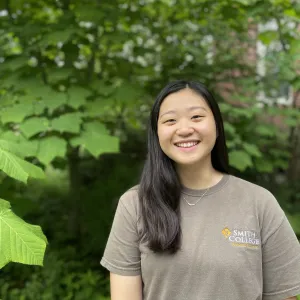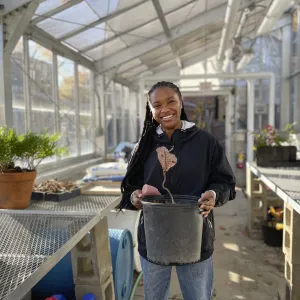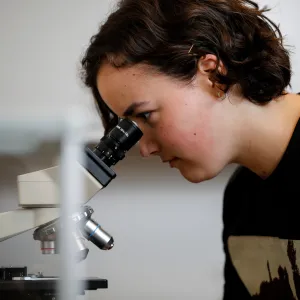Saving the Mountain Magnolia
Sustainability
Climate change has put Magnolia fraseri on an “escalator to extinction” in its native Appalachian mountains. Can Smith researchers figure out how to give the species a future?
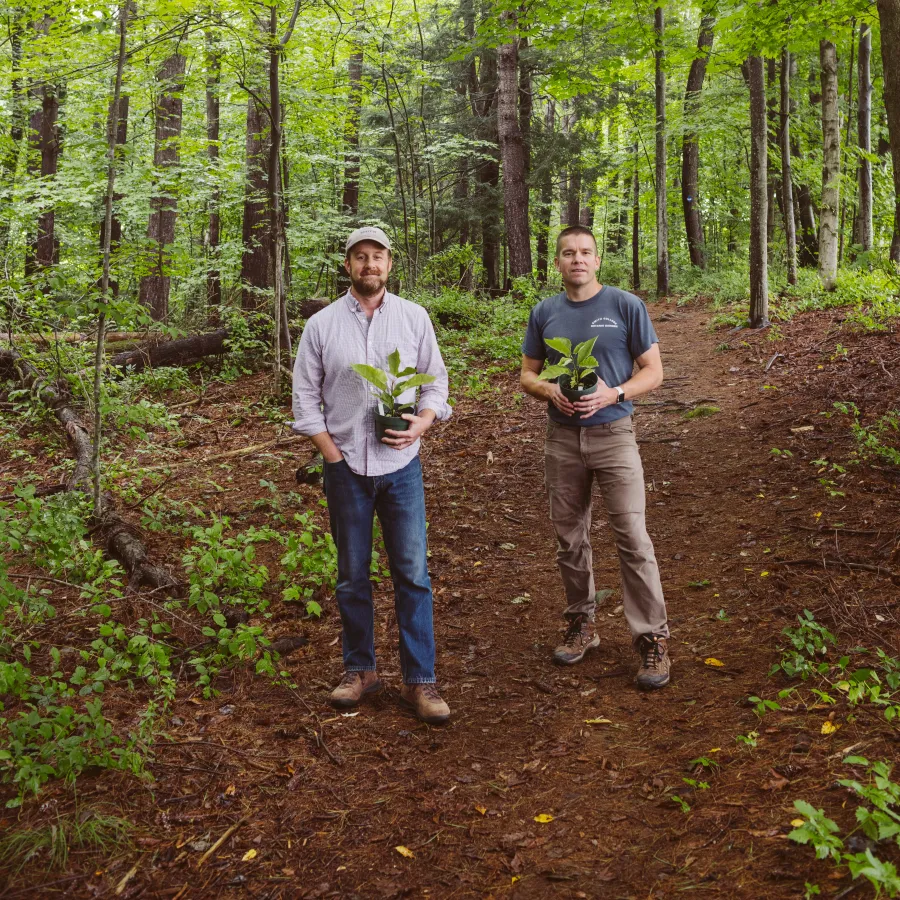
Photograph by Adam Detour
Jesse Bellemare, left, and John Berryhill with young magnolia trees at Smith’s MacLeish Field Station in Whately, Massachusetts.
Published September 25, 2023
Jesse Bellemare and John Berryhill work their way down a wooded path at Smith College’s Ada and Archibald MacLeish Field Station. It’s the kind of warm and cloudy October day when late-fall colors burn more brightly. Barberry, multiflora rose, bittersweet, and autumn olive—all invasive species that claimed the ground when a previous cow pasture was abandoned— have been uprooted and heaped in large piles.
They’re at the Whately, Massachusetts, location to check on a clearing dotted with square research plots. It’s here that a new germination experiment they’re leading is taking place to determine whether magnolia seeds harvested in the southern Appalachians can survive in New England.
On Mountain Day in 2022, a group of student volunteers cleared the ground and planted seeds in rows of 20, encircled by fencing. By October, the field was dotted with colorful flags marking the plots and, if you looked closely enough, rows of toothpicks sticking out of the ground.
There’s not much to see, but Bellemare, associate professor of biological sciences, and Berryhill, Botanic Garden of Smith College landscape curator, stop at each plot and peer tenderly at the toothpicks.
Because this is what it looks like to try to save a species.
Through their work on game-changing research, a small group of Smith students, faculty, and staff has embarked on a mission that has not only helped redefine how the college approaches conservation but has also arguably altered the future of an entire tree species—a magnolia that might have quietly gone extinct on a warming mountaintop if someone had not stepped in to save it.
s a genus, magnolia trees—known for their gorgeous blossoms, broad leaves, and bright fruits— have wide appeal. They have long been used by Native Americans for medicinal purposes, and they are valued by nurseries and landscape companies as popular ornamental plants.
“Everyone likes magnolia. They’re pretty, easy to grow, and don’t have many pests to speak of,” says the U.S. Department of Agriculture’s Todd Rounsaville, who has helped lead efforts to conserve the species Magnolia ashei.
Although tree surveys had long underscored that up to half of all 300-plus magnolia species worldwide were threatened with extinction, assessments of the eight North American species had always seemed more reassuring.
Between the 1980s and 2010s, Magnolia fraseri—commonly known as mountain magnolia or Fraser’s magnolia—was repeatedly listed under the ecological equivalent of “A-OK.” In 2014, the International Union for the Conservation of Nature’s Red List, the global gold standard for assessing species’ extinction risk, assigned the mountain magnolia to the category of least concern, noting that it was thought to have a stable population and no known threats. In 2019, a survey to rank the conservation priority of native U.S. trees didn’t mention Magnolia fraseri, focusing instead on five other species.
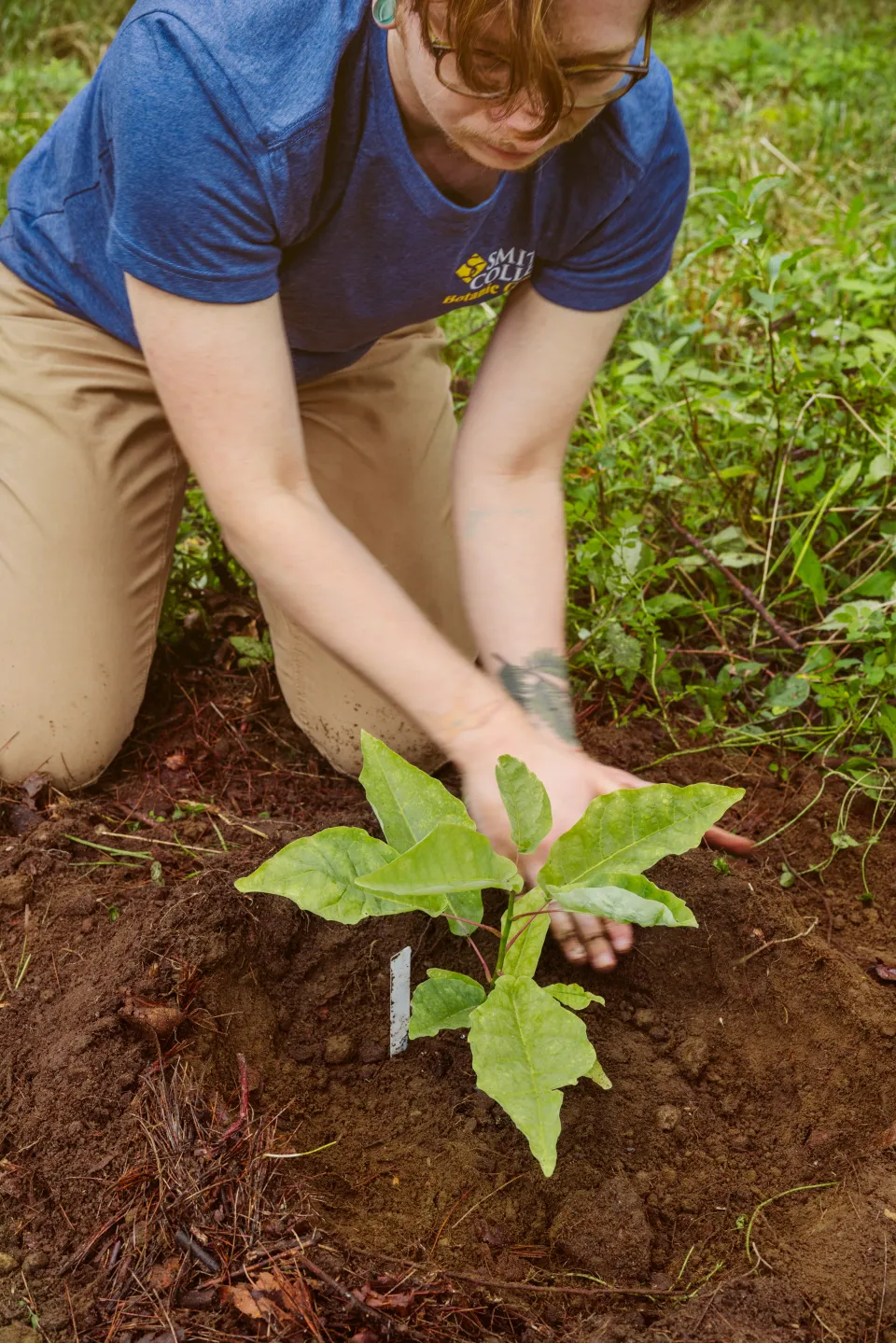
Avery Maltz AC plants the first magnolia that was cultivated as part of the new program. Maltz describes himself as a “secret agent of the plants.” See below for more about him. Photograph by Adam Detour
Mountain magnolia thrives by taking advantage of momentary forest openings. When other trees fall, its seedlings sprout in the sunlight. The species lives for 60 to 70 years, which is on the shorter end for a forest tree. It doesn’t muscle out other trees but rather clusters in small forest pockets where it finds space.
Even in these ecological niches, wild magnolias are critically important. With their extensive canopies and abundant flowers and fruit, the various species provide both shelter and food for an extensive array of animals. They are, as Berryhill notes, a foundational species in the forest.
Bellemare had been studying the state of trees as part of his research into how species might be affected by climate change. In fall 2019, he was joined by Berryhill, who, while still a botanic garden staff member, was also working toward his master’s degree in biological sciences.
Together, as professor and then– grad student, Bellemare and Berryhill decided to focus on a species missing from the 2019 magnolia list. The one they chose to study, Magnolia fraseri, would prove to be ideal for understanding how climate change is affecting native North American trees.
Mountain magnolia is a midslope species that has historically lived at an elevation of between 2,000 and 4,200 feet in the southern Appalachians. It’s not the showiest magnolia, nor is it as easy to cultivate as its relatives. Its habitat also makes wild populations difficult to access. As Berryhill would later write, it was “one of the continent’s most understudied and underappreciated magnolia species.”
In a stable climate, both mature Magnolia fraseri and young seedlings would live together on the same part of a mountain. But with global warming altering the environment, these rugged mountain landscapes were changing drastically.
What Bellemare and Berryhill predicted was that if climate change was causing the habitat to recede upward, older trees might start to get left behind. Seeds and seedlings would only sprout in the new range, moving as far up as they could to follow their preferred climate. On a mountain, that’s possible only to a point, a phenomenon known as the “escalator to extinction.” The idea is simple: There’s only so high a mountain species can go before it runs out of livable space.
“The top of a mountain can represent the end of a road to that escape route,” Berryhill says. And as it ran out of room, the species would also eventually suffer genetic bottlenecks.
In fall 2021, Bellemare and Berryhill headed to the Mount Rogers National Recreation Area in Virginia, returning the following summer with student interns Katie Rahaim AC ’22 and Krystal Bagnaschi ’22. The team identified 10 populations of mountain magnolia, measured survey plots slightly larger than an acre, and counted every tree inside. To determine the ages of the larger trees without harming them, they examined diameters and drilled cores the size of drinking straws. For seedlings too small for core samples, they calculated age by measuring stem growth.
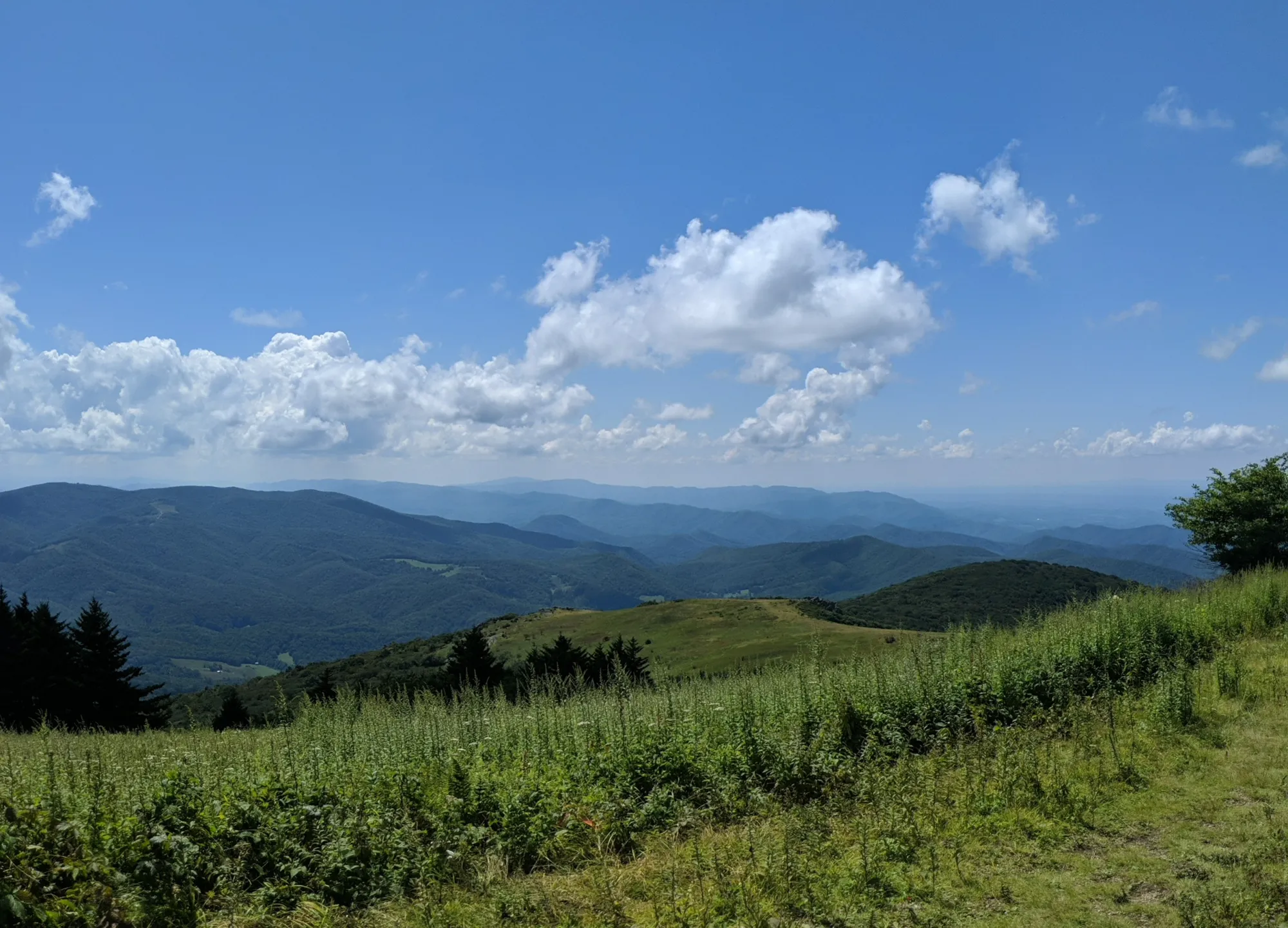
A view from Virginia’s Mount Rogers National Recreation Area, where a Smith team conducted fieldwork. Photograph by Adam Detour
What they found was that mountain magnolia seedlings of all ages were thriving—but almost exclusively at higher elevations. This was even true when they considered the fact that seedlings higher up on the mountain were susceptible to bugs and foraging animals.
But that wasn’t the only startling finding. Even the mature trees were doing better higher up. At the higher elevations, trees were growing 50% more every decade than their lower-elevation counterparts.
The evidence all pointed to the same conclusion: The tree habitat was moving and shrinking. Because it could no longer reproduce lower down, mountain magnolia was not ecologically viable in an estimated two-thirds of its historic range.
“Despite the fact that it’s not a rare species at the moment, this is a very troubling trajectory,” Berryhill says.
Viable habitat was marching northward—and not slowly. By some estimates, in 80 years the climate the mountain magnolia would need to thrive might only be found in pockets throughout New York state and New England. And the pace of change was so rapid that the trees would not be able to get there on their own.
“Just because the world’s on fire doesn’t mean you can’t do something to put it out.”
It was clear that these magnolias were in trouble. Less clear was what should be done to save them.
But those in the field of propagating plants and moving them around don’t like to hedge on maybes. So, every new magnolia grown by a botanic garden will be carefully cataloged and studied to better understand the tree’s proclivities.
Growing and analyzing these trees will require a commitment to “steward these long-lived plants for decades, if not centuries,” Berryhill says. And the problem is increasingly urgent. “The ultimate fate of these tree species may hang on the success of this work,” he adds.
“None of us can wipe our hands and call it done,” agrees Rounsaville, of the USDA, who has distributed plants and seeds to a dozen locations, including Smith, as he helps conserve Magnolia ashei. “There’s a shift for botanic gardens. They’re definitely at the forefront right now.”
In November 2022, Bellemare, Berryhill, and their then-intern Rahaim joined colleagues from the USDA and Botanic Garden Conservation International, a network of botanic gardens and plant conservation experts, to author a study on native magnolia species in the United States and Canada. The study found that, among the 410 collections that reported having some native magnolia species, fewer than 75 locations were growing Magnolia ashei (251 trees) and Magnolia fraseri (190 trees). The conservation gap analysis they produced will now be the guiding framework for botanic garden conservation moving forward.
In USDA terms, every plant that has value as food, a crop, or an ornamental has a curator assigned to it. Curators are charged with collecting, evaluating, researching, and distributing materials for that plant—a large task that means they’re referred to as species stewards or champions.
Timeline: The Changing Landscape of Plant Conservation
This partial timeline highlights the growing concern over plant loss, the initiatives taken by botanic gardens worldwide, and Smith College’s involvement in collaborative conservation efforts. As the global conservation landscape changes, botanic gardens are redefining their roles and emphasizing the need for urgent action to protect plant species from extinction.
Early 1990s| Growing Plant Loss Crisis and Global Treaty on Biological Diversity
• Concerns about a plant loss crisis and its extent prompt the United Nations to create a global treaty on biological diversity.
• The treaty, signed by 150 countries, aims to slow the pace of plant extinctions and encourage better information on plant species.
• The United Nations utilizes the global treaty to call for assessments of all known plant species “as far as possible.”
2000s–2020s| Botanic Gardens Respond to the Crisis
• Botanic gardens worldwide take the call to action seriously and focus on understanding the issue of plant extinction.
• A 2020 report from the British Royal Botanic Gardens, Kew, reveals that two out of every five of the world’s 450,000 plant species are threatened with extinction.
• Botanic Garden Conservation International (BGCI), a membership organization representing botanic gardens in 100-plus countries around the world, lists one-third of all trees as threatened with extinction, including various magnolias.
Present | Botanic Gardens Shift Toward Conservation Ethic
• Botanic gardens increasingly focus on preserving biodiversity, investing time and effort in research and cultivation of endangered and threatened species.
• Noting the growing urgency for plant conservation due to climate change, BGCI establishes umbrella groups called Global Conservation Consortia for six priority tree groups, including magnolias and oaks.
• Smith College faculty, staff, and students actively engage by joining the Global Conservation Consortium for Magnolia, led by the Atlanta Botanic Garden.
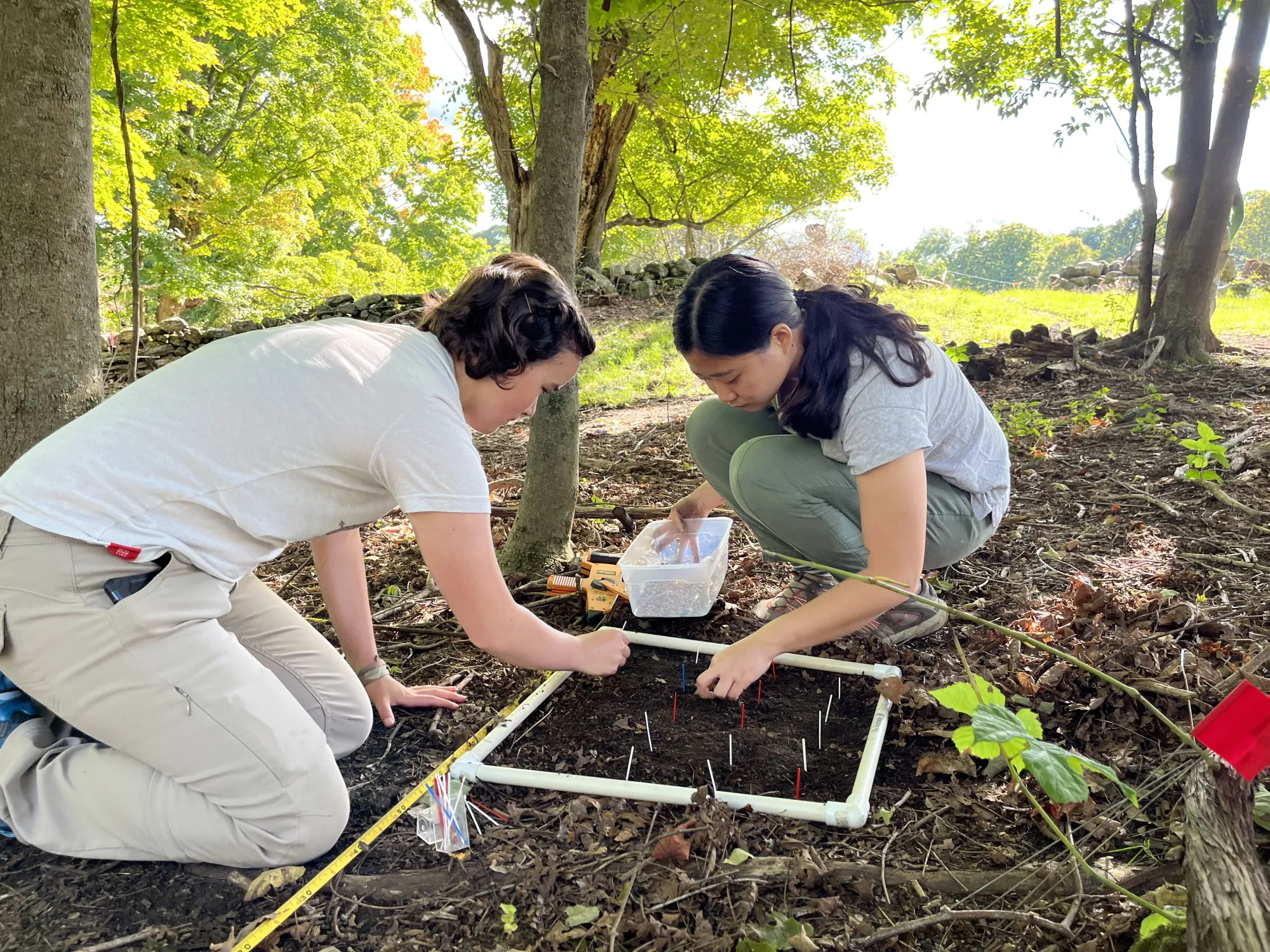
Students at MacLeish Field Station look after recently established research plots with toothpicks marking the locations of magnolia seeds. Photograph by Adam Detour
Unlike the seeds of many other plants— corn, watermelon, or beans, for example—if magnolia seeds dry out, they die. For seed-saving purposes, this makes them difficult to store. A doomsday vault in Fort Collins, Colorado, has recently had success extracting seed embryos and flash-freezing them in liquid nitrogen, but this method is costly and time consuming.
Another strategy is to preserve wild tree populations where they already exist—the in situ conservation method. But, as Bellemare and Berryhill discovered, a wild population like mountain magnolia may struggle to survive in its native locations over the long term.
So, if traditional seed banking was out and on-site conservation was tenuous, what options were left? To maintain enough genetic diversity, threatened magnolias would need to be grown elsewhere. But this type of conservation—an ex situ approach, or living gene bank—would require growing many trees, which in turn would require a lot of space.
Moving a plant from one region to another is also not without controversy. After all, many invasive species can be traced back to human intervention of one kind or another. That said, a magnolia tree is a slow-growing, slow-moving plant that doesn’t monopolize its habitat to the detriment of other flora (unlike a kudzu vine, say, or Japanese knotweed), and mountain magnolia might have already grown in New England before the most recent ice age pushed it south.
The USDA’s Agricultural Research Service is the steward for Magnolia ashei; in spring 2023, in recognition of the vast work that it had already done, Smith College was named the species champion for Magnolia fraseri.
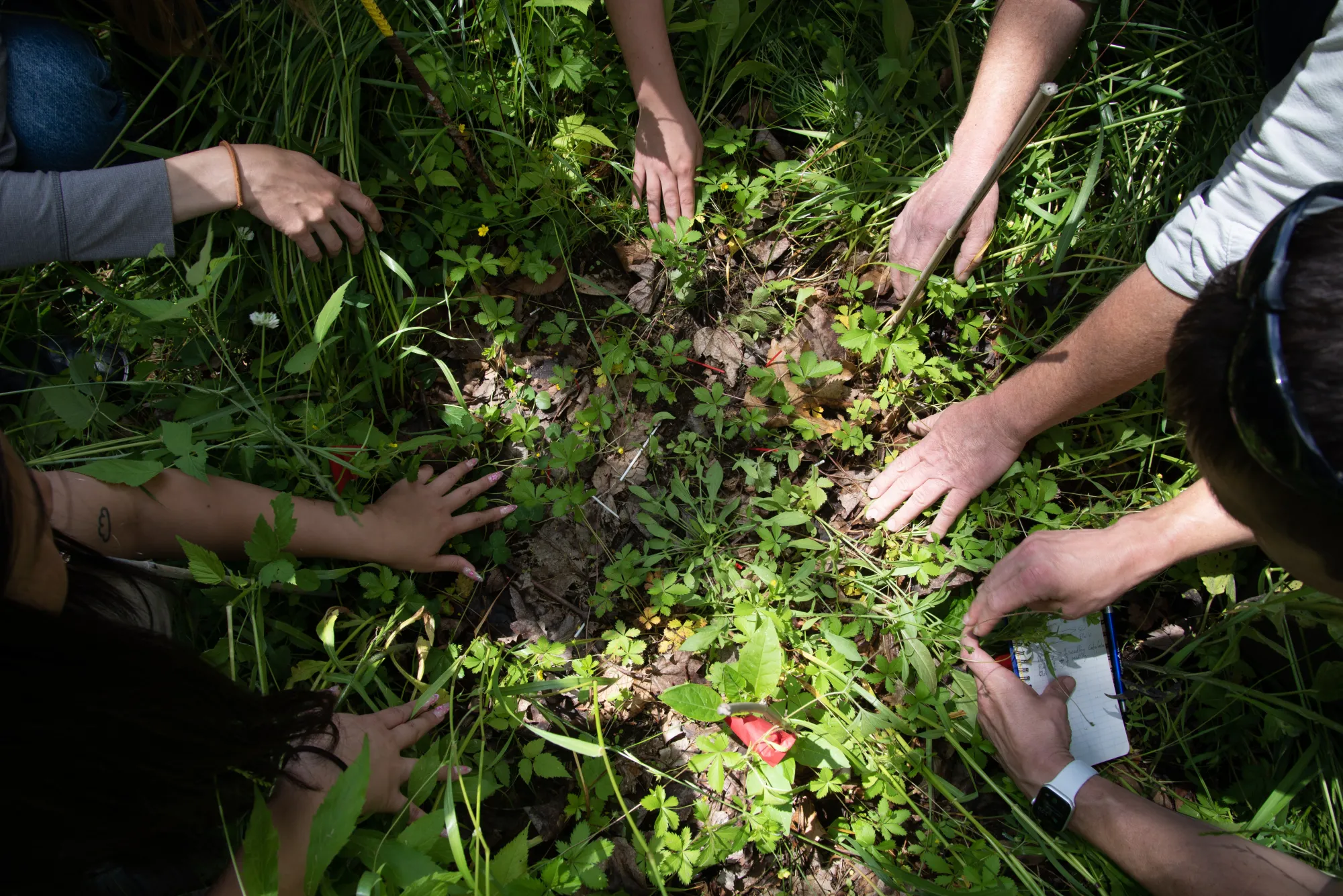
Photograph by Adam Detour
Botanic Gardens Redefine Their Role for Today’s World
It’s a warm, sunny June day, and Bellemare, Berryhill, and six students caravan to the MacLeish Field Station. In the parking lot, they make friendly bets for a small chocolate prize. How many of the magnolia seeds from the fall planting experiment have germinated? Berryhill guesses eight; one student guesses as many as 50.
In the field, they push through waist-high grasses and weeds to the wire enclosures, and Bellemare begins poking aside leaves with a stick. With 20 seeds in each research plot and an estimated 20% germination rate, there should be at least a few sprouting trees. The group finds none in the first spot. In the second, as the students cluster close, Bellemare points out a tiny plant unfurling its first two leaves. “There’s one right there,” he says, estimating that it sprouted a week before.
The group laughs with relief. Moving to the next enclosure, Avery Maltz AC notes that, regardless of the outcome, the visit offers valuable lessons.
“Through doing all the rare plant surveys, I’ve learned that it’s equally exciting to just see what’s there, even if you don’t find the plants,” Maltz says. “There’s just so much information in everything you’re looking at, whether the plant has come out of the ground or not.”
The group will eventually find eight or nine tiny magnolias popping out of the ground—a good sign. The mountain species can survive New England winters, it seems, but not in such numbers to suggest that it might become invasive. As it’s early in the growing season, Bellemare and Berryhill make a plan to return later in the summer.
There is a great deal of research yet to be done, but the prospect of saving a species makes Maltz grin. “It’s very exciting. For me, it just feels like the beginning of getting to watch this new story unfold.”
Rachael Hanley Hagerstrom ’02 is the social media manager at Smith College.

